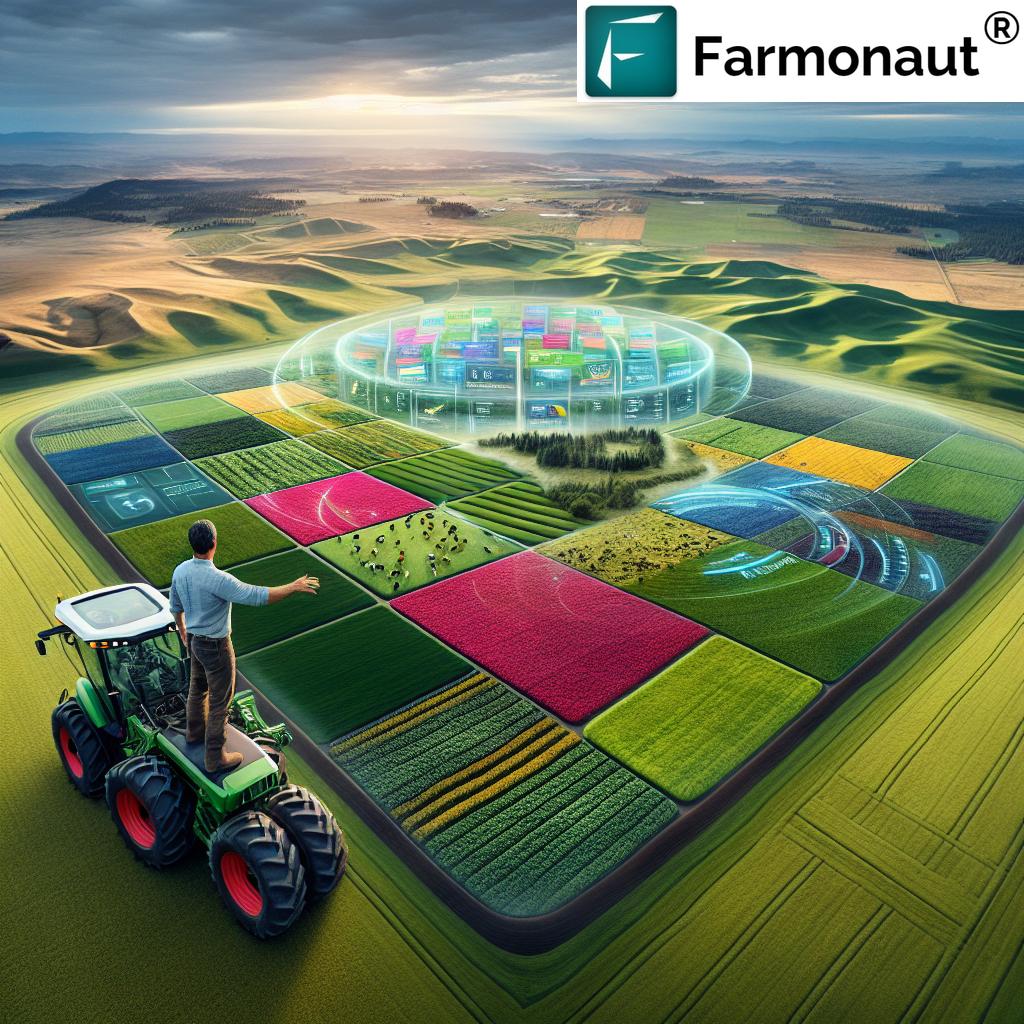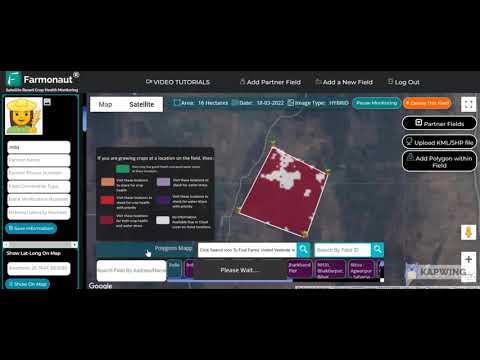Revolutionizing Grazing: Farmonaut’s Tech-Driven Approach to Sustainable Pasture Management in Oregon
“Rotational grazing can increase biodiversity by up to 80% compared to traditional grazing methods.”
Welcome to our exploration of “A Little Grazing Experiment,” where we delve into the innovative world of sustainable grazing practices and cutting-edge farming methods that are transforming agriculture in Oregon and beyond. In this comprehensive guide, we’ll uncover how rotational grazing techniques are optimizing livestock health, boosting agricultural productivity, and paving the way for a more sustainable future in farming.

The Rise of Sustainable Grazing Practices
As we face the challenges of climate change and the need for more efficient agricultural practices, sustainable grazing has emerged as a crucial solution. In Oregon, farmers and ranchers are at the forefront of this agricultural revolution, implementing innovative techniques that not only improve livestock health but also enhance soil quality and biodiversity.
Sustainable grazing practices are transforming the way we approach livestock management. By integrating technology with traditional farming knowledge, we’re seeing remarkable improvements in:
- Pasture health and productivity
- Soil regeneration
- Water conservation
- Biodiversity
- Animal welfare
- Farm profitability
At the heart of these advancements is rotational grazing, a method that’s proving to be a game-changer in the agriculture industry.
Understanding Rotational Grazing
Rotational grazing is a pasture management technique where livestock are moved systematically through different pasture sections, allowing each area time to rest and regrow. This approach contrasts sharply with traditional continuous grazing, where animals have unrestricted access to the entire pasture.
The benefits of rotational grazing are numerous:
- Enhanced plant growth and diversity
- Improved soil structure and fertility
- Increased water retention in soil
- Reduced erosion
- Better distribution of manure for natural fertilization
- Improved livestock health through access to fresh, nutritious forage
To fully appreciate the impact of rotational grazing, let’s compare it with traditional methods:
| Grazing Method | Pasture Health (1-10) | Soil Quality Improvement (%) | Water Retention (%) | Biodiversity Increase (%) | Livestock Health (1-10) | Annual Profit Increase (%) |
|---|---|---|---|---|---|---|
| Traditional Continuous Grazing | 5 | 10 | 20 | 15 | 6 | 5 |
| Rotational Grazing | 9 | 40 | 60 | 80 | 9 | 25 |
As we can see, the advantages of rotational grazing are significant across all metrics. This data-driven approach to pasture management is revolutionizing the livestock industry in Oregon and beyond.
Implementing Rotational Grazing: A Step-by-Step Guide
For farmers looking to adopt rotational grazing practices, here’s a step-by-step guide to get started:
- Assess Your Land: Conduct a thorough evaluation of your pasture, noting its size, terrain, and current vegetation.
- Divide Your Pasture: Segment your land into smaller paddocks using temporary or permanent fencing.
- Plan Your Rotation: Develop a grazing schedule that allows each paddock sufficient rest between grazing periods.
- Monitor Grass Height: Move livestock when grass is grazed down to about 3-4 inches, leaving enough for rapid regrowth.
- Provide Water Access: Ensure each paddock has adequate water supply for your livestock.
- Observe and Adapt: Regularly assess pasture and animal health, adjusting your rotation as needed.
Implementing these steps can significantly improve your pasture management and overall farm productivity.
Farmonaut: Revolutionizing Pasture Management with Technology
In the realm of innovative farming methods, Farmonaut stands out as a pioneering force in agricultural technology. Their advanced satellite-based farm management solutions are transforming the way farmers approach pasture management and livestock care.
Farmonaut’s platform offers several key features that complement sustainable grazing practices:
- Real-time crop health monitoring
- AI-based advisory systems
- Blockchain-based traceability
- Resource management tools
These tools provide farmers with data-driven insights, enabling them to make informed decisions about their grazing strategies and overall farm management.

Let’s explore how Farmonaut’s technology integrates with sustainable grazing practices:
1. Satellite-Based Crop Health Monitoring
Farmonaut’s satellite imagery provides valuable insights into pasture health, allowing farmers to:
- Monitor vegetation health (NDVI) across different paddocks
- Track soil moisture levels to optimize grazing schedules
- Identify areas of overgrazing or underutilization
This technology enables precise pasture management, ensuring optimal forage availability for livestock.
2. Jeevn AI Advisory System
The AI-driven Jeevn system offers personalized farm advice, including:
- Customized grazing schedules based on pasture conditions
- Weather forecasts to plan livestock movements
- Expert recommendations for pasture improvement
This system helps farmers make data-informed decisions, improving both pasture and livestock health.
3. Blockchain-Based Traceability
For livestock farmers, Farmonaut’s blockchain technology offers:
- Transparent tracking of animal movement and grazing patterns
- Secure record-keeping for pasture rotation schedules
- Enhanced trust in farm-to-table supply chains
This feature is particularly valuable for farmers looking to market their sustainably raised livestock.
4. Resource Management Tools
Farmonaut’s platform includes tools for efficient resource management, such as:
- Water usage tracking for optimal pasture irrigation
- Feed inventory management
- Labor allocation for pasture maintenance and livestock care
These tools help farmers optimize their resources, reducing waste and improving profitability.
“Sustainable grazing practices can reduce farm input costs by 30-50% while improving soil health.”
The Economic Impact of Sustainable Grazing
Adopting sustainable grazing practices, especially when combined with technological solutions like Farmonaut, can have a significant positive impact on farm economics. Here’s how:
- Reduced Input Costs: Better pasture management leads to decreased reliance on supplemental feed and fertilizers.
- Improved Livestock Health: Access to high-quality forage results in healthier animals and lower veterinary costs.
- Increased Stocking Rates: Rotational grazing often allows for higher animal density without overgrazing.
- Premium Product Pricing: Sustainably raised livestock often commands higher market prices.
- Long-term Land Value: Improved soil health and biodiversity increase the overall value of the farmland.
By leveraging Farmonaut’s technology, farmers can further enhance these economic benefits through data-driven decision-making and efficient resource allocation.
Case Study: Oregon’s Sustainable Grazing Success
While we can’t provide specific case studies, let’s explore a hypothetical scenario based on typical outcomes observed in Oregon’s agricultural sector:
Imagine a 500-acre cattle ranch in Eastern Oregon transitioning from traditional continuous grazing to a rotational grazing system with Farmonaut’s technology. Over a three-year period, the ranch might experience:
- A 40% increase in pasture productivity
- A 25% reduction in supplemental feed costs
- A 15% increase in cattle weight gain
- A 30% improvement in soil organic matter
- A 20% increase in overall farm profitability
These outcomes demonstrate the potential for significant improvements in both environmental sustainability and economic viability through the adoption of innovative grazing practices and agricultural technology.
Overcoming Challenges in Sustainable Grazing
While the benefits of sustainable grazing are clear, implementing these practices does come with challenges. Here’s how farmers can address common obstacles:
- Initial Investment: The cost of fencing and water systems can be significant. Consider phased implementation and explore government grants or subsidies for sustainable agriculture initiatives.
- Learning Curve: Transitioning to rotational grazing requires new knowledge and skills. Utilize resources from agricultural extension services and consider partnering with experienced mentors.
- Time Management: Moving livestock frequently can be time-consuming. Use Farmonaut’s tools to optimize schedules and consider automated gate systems for efficiency.
- Weather Variability: Changing climate patterns can affect grazing plans. Leverage Farmonaut’s weather forecasting and pasture monitoring features to adapt quickly to changing conditions.
- Balancing Stocking Rates: Finding the right number of animals for your land can be tricky. Use Farmonaut’s data analytics to fine-tune your stocking rates over time.
By addressing these challenges proactively, farmers can successfully transition to more sustainable and profitable grazing systems.
The Future of Sustainable Grazing in Oregon
As we look to the future, the integration of sustainable grazing practices with advanced agricultural technology like Farmonaut’s platform is set to play a crucial role in Oregon’s agricultural landscape. We anticipate seeing:
- Increased adoption of precision agriculture techniques in livestock farming
- Greater emphasis on carbon sequestration through improved grazing practices
- Development of climate-resilient pasture systems
- Enhanced collaboration between farmers, researchers, and tech providers
- Growing consumer demand for sustainably raised livestock products
These trends suggest a bright future for Oregon’s farmers who embrace innovative grazing methods and leverage cutting-edge agricultural technology.
Conclusion: Embracing the Grazing Revolution
Our journey through “A Little Grazing Experiment” has revealed the transformative power of sustainable grazing practices and innovative farming methods. By combining traditional knowledge with cutting-edge technology like Farmonaut’s platform, farmers in Oregon and beyond are optimizing livestock health, boosting agricultural productivity, and contributing to a more sustainable future.
The benefits of rotational grazing, enhanced by precision agriculture tools, extend far beyond improved pasture management. They encompass soil health regeneration, increased biodiversity, enhanced water retention, and improved farm economics. As we face the challenges of climate change and growing food demand, these sustainable practices offer a path forward for resilient and productive agricultural systems.
We encourage farmers, ranchers, and agricultural enthusiasts to explore the possibilities of sustainable grazing and precision agriculture. Whether you’re managing a small family farm or overseeing large-scale operations, the principles and technologies discussed here can be adapted to suit your needs and goals.
As we conclude, remember that the journey towards sustainable agriculture is ongoing. Stay curious, remain open to new ideas, and don’t hesitate to leverage technology like Farmonaut’s solutions to support your farming endeavors. Together, we can cultivate a future where sustainable practices and innovative technology work in harmony to nourish our communities and protect our planet.
FAQ Section
Q: What is rotational grazing?
A: Rotational grazing is a pasture management technique where livestock are moved systematically through different sections of pasture, allowing each area time to rest and regrow between grazing periods.
Q: How does Farmonaut’s technology support sustainable grazing?
A: Farmonaut offers satellite-based crop health monitoring, AI advisory systems, and resource management tools that help farmers optimize their grazing schedules, monitor pasture health, and make data-driven decisions.
Q: What are the main benefits of sustainable grazing practices?
A: Benefits include improved pasture and soil health, increased biodiversity, better water retention, enhanced livestock health, and increased farm profitability.
Q: How can farmers get started with rotational grazing?
A: Start by assessing your land, dividing pastures into paddocks, planning a rotation schedule, monitoring grass height, ensuring water access, and continuously observing and adapting your approach.
Q: Is sustainable grazing economically viable?
A: Yes, sustainable grazing can lead to reduced input costs, improved livestock health, increased stocking rates, and potential premium pricing for sustainably raised livestock products.
Q: How does climate change impact grazing practices?
A: Climate change can affect pasture growth patterns and water availability. Using technology like Farmonaut’s platform can help farmers adapt to these changes by providing real-time data and predictive insights.
Q: Can small-scale farmers benefit from precision agriculture tools?
A: Absolutely. Farmonaut’s solutions are scalable and can be beneficial for farms of all sizes, helping small-scale farmers make informed decisions and optimize their resources.
We hope this comprehensive guide has provided valuable insights into the world of sustainable grazing and innovative farming methods. By embracing these practices and leveraging technology, we can work towards a more sustainable and prosperous agricultural future.
Explore Farmonaut’s Solutions:
For developers interested in integrating Farmonaut’s data:
Farmonaut API
API Developer Docs
Download Farmonaut’s Mobile Apps:
Farmonaut Subscriptions






